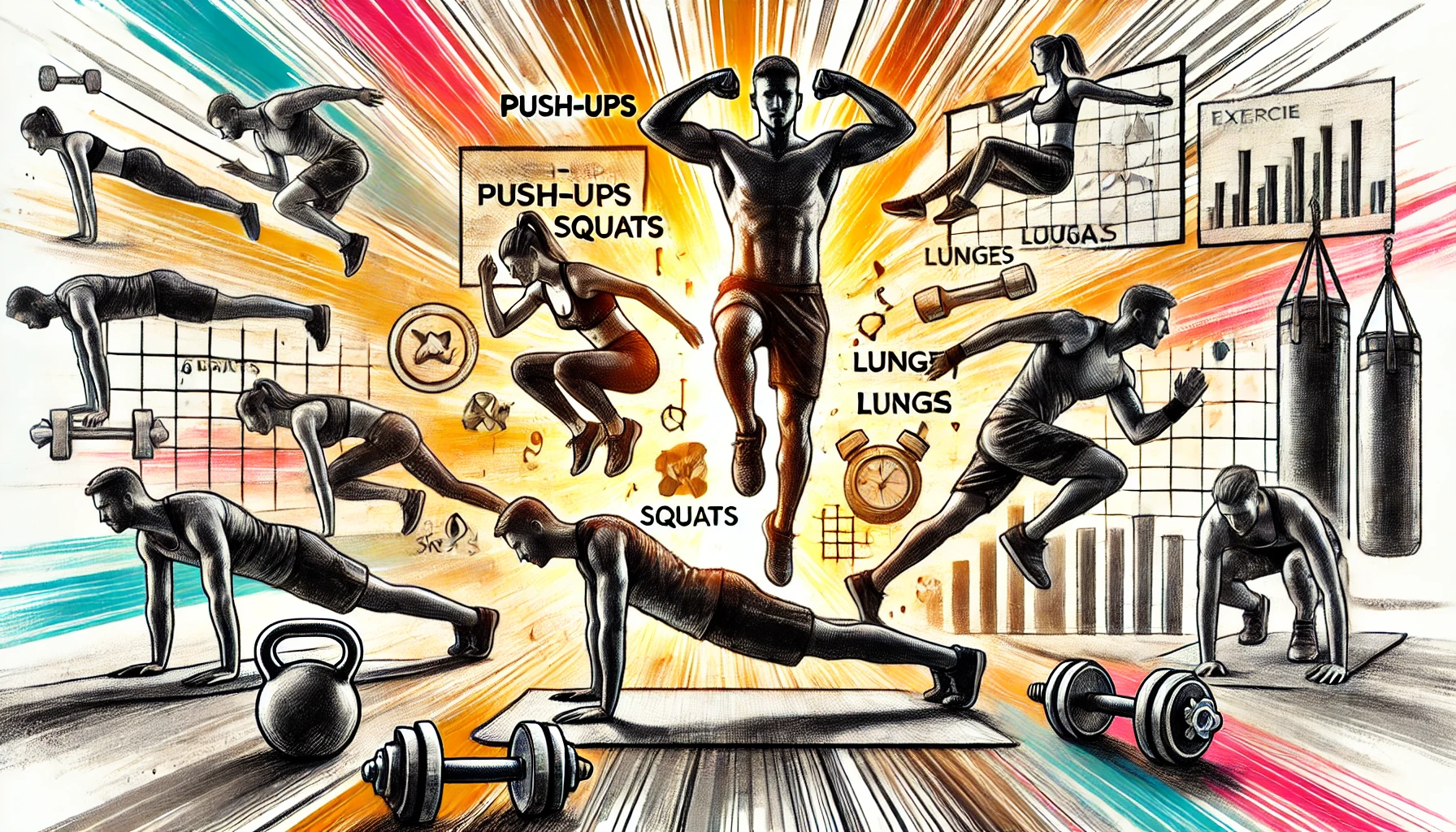Finding the right exercises for your workout routine can be a challenge, especially with the sheer number of options out there. Whether you’re new to fitness or a seasoned athlete, knowing the names and types of exercises available can help you create an effective and varied workout plan. This guide will walk you through a comprehensive list of exercise names, their benefits, and how to incorporate them into your routine.
Why Knowing Exercise Names Matters
Understanding the names of exercises is more than just gym jargon. It empowers you to:
- Follow workout plans accurately.
- Communicate effectively with trainers and fellow gym-goers.
- Expand your workout repertoire and avoid monotony.
- Ensure you’re targeting all major muscle groups.
Exercise Categories
Exercises can be categorized based on the body part they target or the type of movement they involve. Here’s a breakdown of the main categories:
- Upper Body Exercises
- Lower Body Exercises
- Core Exercises
- Cardio Exercises
- Flexibility and Mobility Exercises
- CrossFit Exercises
Upper Body Exercises
1. Push-Ups
Push-ups are a staple in many workout routines and for good reason. They target the chest, shoulders, and triceps.
- Standard Push-Up: Hands shoulder-width apart, body in a straight line, lower yourself until your chest nearly touches the ground, and push back up.
- Wide Push-Up: Hands wider than shoulder-width apart to emphasize the chest muscles.
- Diamond Push-Up: Hands together under your chest to target the triceps more intensively.
2. Pull-Ups and Chin-Ups
These exercises are excellent for building back and bicep strength.
- Pull-Up: Overhand grip on a bar, pull yourself up until your chin is above the bar.
- Chin-Up: Underhand grip on a bar, pull yourself up until your chin is above the bar.
3. Shoulder Press
A powerful move for shoulder strength.
- Standing Shoulder Press: Use dumbbells or a barbell, press weights overhead until arms are fully extended.
- Seated Shoulder Press: Similar to the standing press but performed sitting down for better stability.
Lower Body Exercises
1. Squats
Squats are fundamental for lower body strength, targeting the quads, hamstrings, and glutes.
- Bodyweight Squat: Feet shoulder-width apart, lower yourself until your thighs are parallel to the ground, and stand back up.
- Goblet Squat: Hold a dumbbell close to your chest while performing a squat.
- Barbell Back Squat: With a barbell on your shoulders, squat down and stand up.
2. Lunges
Great for leg strength and balance.
- Forward Lunge: Step forward with one leg, lower your hips until both knees are bent at 90 degrees, and return to the starting position.
- Reverse Lunge: Step backward instead of forward to target the glutes differently.
- Walking Lunge: Perform lunges in a walking motion across the floor.
3. Deadlifts
Deadlifts are fantastic for the posterior chain, including the hamstrings, glutes, and lower back.
- Conventional Deadlift: Barbell on the ground, feet shoulder-width apart, lift the bar by extending your hips and knees.
- Romanian Deadlift: Focuses more on the hamstrings by keeping legs slightly bent and lowering the barbell to mid-shin level.
- Sumo Deadlift: Wider stance and hands inside the legs to emphasize the inner thighs.
Core Exercises
1. Planks
Planks are essential for core stability.
- Standard Plank: Hold a push-up position with your body in a straight line from head to heels.
- Side Plank: On your side, support your body with one arm and the side of one foot.
- Plank with Leg Lift: Standard plank position, lift one leg at a time to add difficulty.
2. Sit-Ups and Crunches
Classic core moves for abdominal strength.
- Sit-Up: Lie on your back with knees bent, sit up, and touch your toes.
- Crunch: Similar to a sit-up but with less range of motion, focusing on the upper abs.
- Bicycle Crunch: Alternating opposite elbows to knees in a cycling motion.
3. Russian Twists
Great for oblique muscles.
- Russian Twist: Sit on the floor with knees bent, lean back slightly, and twist your torso from side to side, touching the floor on each side.
Cardio Exercises
1. Running
Running is an excellent cardio exercise for overall fitness.
- Treadmill Running: Indoor running on a treadmill with adjustable speed and incline.
- Trail Running: Outdoor running on natural trails, which adds a variety of terrain and challenges.
- Interval Running: Alternating between high-intensity sprints and low-intensity jogging.
2. Cycling
Cycling is great for cardiovascular health and lower body strength.
- Stationary Bike: Indoor cycling with adjustable resistance.
- Road Cycling: Outdoor cycling on roads or bike paths.
- Mountain Biking: Off-road cycling on rough terrain for an added challenge.
3. Jump Rope
A fun and effective cardio workout.
- Basic Jump: Standard two-foot jump.
- High Knees Jump: Bringing knees up high with each jump for added intensity.
- Double Under: Swing the rope under your feet twice with each jump.
Flexibility and Mobility Exercises
1. Yoga
Yoga combines flexibility, strength, and mindfulness.
- Downward Dog: Hands and feet on the ground, hips raised to form an inverted V shape.
- Warrior Pose: A series of standing postures that enhance strength and balance.
- Child’s Pose: Kneeling on the floor with arms extended forward, resting your forehead on the ground.
2. Stretching
Important for flexibility and muscle recovery.
- Hamstring Stretch: Sitting on the floor, reach for your toes to stretch the back of your thighs.
- Quadriceps Stretch: Standing, pull one foot up behind you to stretch the front of your thigh.
- Shoulder Stretch: Bring one arm across your body and hold it with the other arm.
3. Foam Rolling
Helps in muscle recovery and reducing soreness.
- Upper Back Roll: Lie on a foam roller under your upper back and roll back and forth.
- IT Band Roll: Lie on your side with the foam roller under your hip and roll down to your knee.
- Calf Roll: Sit with the foam roller under your calves and roll back and forth.
CrossFit Exercises
CrossFit combines strength training, cardio, and bodyweight exercises into high-intensity workouts. Here are some common CrossFit exercises:
1. Burpees
A full-body exercise that combines a squat, push-up, and jump.
- Standard Burpee: Start standing, drop into a squat with hands on the ground, kick feet back into a push-up position, perform a push-up, return to squat, and jump up.
2. Box Jumps
Great for building explosive power in the legs.
- Box Jump: Jump from the ground onto a sturdy box or platform and step back down.
3. Kettlebell Swings
A dynamic exercise for the posterior chain and shoulders.
- Kettlebell Swing: Swing a kettlebell between your legs and up to shoulder height using hip thrusts.
4. Wall Balls
Combines a squat and an overhead throw.
- Wall Ball: Squat while holding a medicine ball, stand up and throw the ball against a wall at a target height, catch it, and repeat.
5. Thrusters
Combines a squat and a press.
- Thruster: Hold a barbell or dumbbells at shoulder height, squat down, and as you stand up, press the weights overhead.
6. Double Unders
An advanced jump rope exercise.
- Double Under: Jump rope while swinging the rope twice under your feet with each jump.
7. Clean and Jerk
A compound lift for total body strength.
- Clean and Jerk: Lift a barbell from the ground to shoulders (clean) and then overhead (jerk).
8. Snatch
A powerful Olympic lift.
- Snatch: Lift a barbell from the ground to overhead in one continuous motion.
9. Pistols
A challenging single-leg squat.
- Pistol Squat: Stand on one leg, lower yourself into a squat while keeping the other leg extended forward, and return to standing.
10. Toe-to-Bars
A core exercise that also engages the upper body.
- Toe-to-Bar: Hang from a pull-up bar and lift your legs up to touch the bar with your toes.
11. Bar Muscle-Ups
A combination of a pull-up and a dip.
- Bar Muscle-Up: Pull yourself up over a pull-up bar and then push your chest above the bar to complete the movement.
12. Handstand Push-Ups
An advanced upper body exercise.
- Handstand Push-Up: Kick up into a handstand against a wall and lower your head to the ground, then push back up.
13. Handstand Walks
A skillful balance and strength exercise.
- Handstand Walk: Walk on your hands while maintaining a handstand position.
Putting It All Together: Creating a Balanced Workout Plan
A well-rounded workout plan should include exercises from each category to ensure all muscle groups are targeted and different types of fitness are addressed. Here’s a sample weekly workout plan:
- Monday: Upper Body (Push-Ups, Pull-Ups, Shoulder Press)
- Tuesday: Lower Body (Squats, Lunges, Deadlifts)
- Wednesday: Cardio (Running, Cycling, Jump Rope)
- Thursday: Core (Planks, Sit-Ups, Russian Twists)
- Friday: CrossFit (Burpees, Box Jumps, Kettlebell Swings, Wall Balls)
- Saturday: Lower Body (Squats, Lunges, Deadlifts)
- Sunday: Flexibility and Mobility (Yoga, Stretching, Foam Rolling)
Conclusion
Understanding the names and types of exercises available can significantly enhance your workout routine. By incorporating a variety of exercises, you can target all major muscle groups, improve cardiovascular health, and increase flexibility. Remember to listen to your body, progress at your own pace, and enjoy the journey to better fitness.
For more detailed exercise guides and workout plans, check out resources like Bodybuilding.com, ACE Fitness, and Men’s Health. Happy training!
By familiarizing yourself with these exercise names and incorporating them into your routine, you’re setting yourself up for a balanced and effective fitness journey. Let’s get moving!






[…] If you are enjoying this article, then you will also like our Ultimate guide to exercise names […]